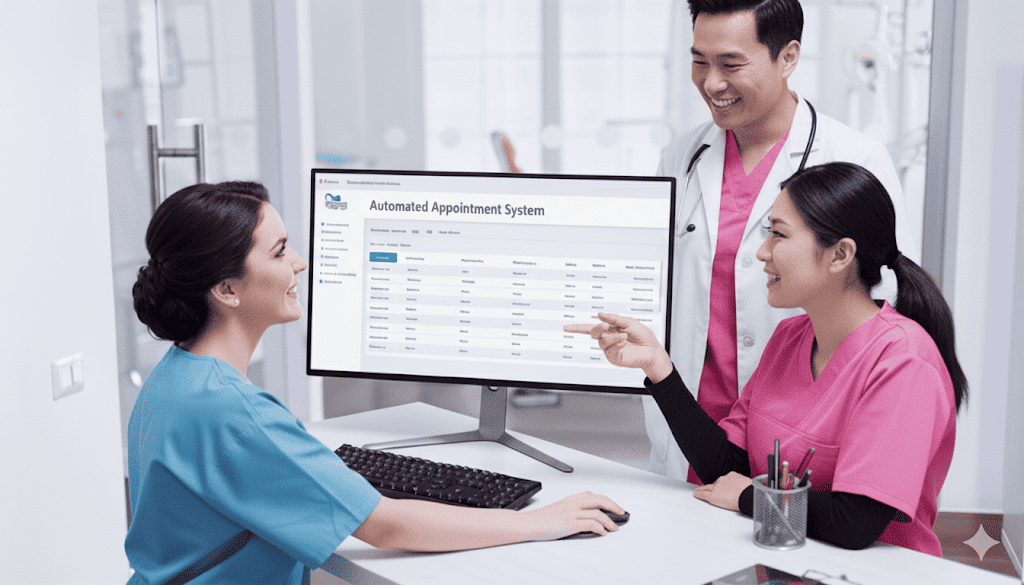How to Set Up HIPAA-Compliant Text Reminders in AdvancedMD
💡 Clinics today need to know how to set up HIPAA-compliant text reminders in AdvancedMD. This starts with ensuring messages are secure, compliant,...
6 min read
Gregory Vic Dela Cruz : Updated on September 10, 2025
.png)
Every missed appointment represents more than an empty slot. It’s lost revenue, wasted staff time, and delayed care for patients who need it. Studies show that no-shows can cost small clinics thousands of dollars each month. No-shops also create ripple effects that reduce overall efficiency. The good news is that a simple, cost-effective solution already exists: appointment reminders.
Appointment reminders cuts through the noise of busy schedules, keeping patients on track. For many people, healthcare isn’t top of mind when juggling work, family, and other tasks. Without a nudge, even patients with the best intentions may forget. That’s why healthcare practices are adopting SMS reminders for healthcare. And this goes beyond generic alerts to include instructions, confirmations, and rescheduling options.
This article is a complete guide on how appointment reminders reduce no-shows in clinics. We’ll break down the following:
Finally, we’ll show how eCW users can use integrated reminder solutions like Curogram. Learn how you can combine automation, customization, and compliance into one seamless workflow.
We've previously dug deep into why no-shows occur, and the most common reasons include the following:
One of the most common reasons patients miss appointments is simply forgetting. Life is busy, and healthcare isn’t always a priority. Without reminders, it’s easy for patients to overlook scheduled visits. Appointment reminders reduce no-shows by bringing the visit back into focus at the right time.
Another major factor is confusion. Patients may not recall the exact time, location, or preparation instructions. A misplaced sticky note or unclear voicemail can result in a missed visit. Appointment confirmation messages sent through text or email eliminate this miscommunication by providing clear, written details.
Not all no-shows are due to forgetfulness. Some patients face real obstacles like unreliable transportation, financial stress, or anxiety about the visit itself. While reminders can’t remove all barriers, they do give patients the opportunity to cancel or reschedule, freeing up slots for others. SMS reminders for healthcare can even include links to reschedule online or request transportation assistance, making attendance easier for vulnerable populations.
Understanding why patients miss visits is the first step toward solving the problem. The next step is putting proven strategies in place, and appointment reminders are one of the most effective tools available.
Automated appointment reminders act as timely nudges that keep patients aware of their upcoming visits. Text messages are particularly effective because most people carry their phones everywhere. Appointment reminder text messages allow patients to confirm with a single tap, immediately updating the clinic’s schedule.
Reminder messages aren’t just about dates and times—they can include essential preparation details like fasting instructions, bringing lab results, or clinic directions. By sending these instructions in advance, clinics reduce same-day cancellations due to confusion.
When patients can’t make it, the ability to cancel or reschedule by replying to a text prevents wasted slots. This flexibility ensures schedules remain full while reducing staff burden. SMS reminders for healthcare improve efficiency by allowing staff to fill vacated slots quickly.
Consistent, professional reminders signal to patients that the clinic is organized and values their time. Appointment confirmation messages help build trust by making patients feel cared for and supported. This reliability encourages stronger relationships and better long-term retention.
In practice, appointment reminders reduce no-shows with reminders by tackling each cause of missed visits—forgetfulness, confusion, and barriers—head-on.
Text reminders are the most effective channel, with a 98% open rate. Appointment reminder text messages reach patients instantly and allow quick confirmations or reschedules. Automated appointment reminders can even personalize texts with patient names, provider details, and visit instructions.
Email is better for detailed instructions, such as pre-procedure prep, but engagement rates are lower compared to text. While useful, email should be paired with other methods to maximize impact.
Reminder calls vs text reminders is an important consideration. Phone calls remain useful, particularly for older patients who may not use text messaging. However, they are resource-intensive and harder to scale. Automated systems can handle some of this workload, but staff time is still required.
The best practices for appointment reminders involve combining channels. A text reminder 48 hours before, an email with detailed instructions, and a same-day call for high-risk patients provides the most comprehensive coverage. This ensures no patient slips through the cracks.
By implementing a multi-channel strategy, clinics maximize engagement and reduce patient no-shows with reminders significantly.
Across specialties, clinics report significant gains when they implement automated appointment reminders. By sending timely appointment reminder text messages that include clear instructions and a one-tap confirm/reschedule option, many organizations see a 20–30% decrease in missed visits. This isn’t just about sending messages—it’s about using SMS reminders for healthcare that are synchronized to the schedule, easy to act on, and written in patient-friendly language. As appointment reminders reduce no-shows, providers reclaim otherwise wasted slots, stabilize daily throughput, and improve revenue predictability.
Same-day cancellations in imaging often happen because patients miss critical preparation steps (e.g., fasting, hydration, attire). Embedding concise prep checklists directly in text reminders dramatically lowers avoidable cancels. Best practices for appointment reminders include sending a 48-hour message with prep details and a same-day “ready to go” reminder. This combination helps patients arrive prepared, reduces reschedules, and keeps modality utilization high.
Virtual visits fail when patients can’t find their link at the moment it’s needed. Automated appointment reminders that include the secure visit URL (or “Join Visit” button) right before the session dramatically lift show rates. For high-risk cohorts, layering channels—text plus email—ensures the link is always handy. The result: fewer no-connect incidents, shorter technician support time, and higher completed-visit counts.
Backup path: Include a plain URL and quick troubleshooting tips in the message.
.png?width=1536&height=1024&name=how%20appointment%20reminders%20reduce%20no-shows%20in%20clinics%20-%20mid%20(1).png)
When reminders pull appointment data straight from eCW, details like date, time, provider, location, and visit type stay accurate—no manual copying. This alignment reduces human error, ensures that changes (like provider swaps or time shifts) flow into the next outgoing reminder, and keeps front-desk staff out of “double work.” In short, syncing from eCW is foundational to how appointment reminders reduce no-shows in clinics without adding administrative burden.
Different patients prefer different channels. With eCW-connected workflows, clinics can automate SMS, email, and (when needed) outbound calls in a thoughtful cadence—48 hours, 24 hours, and same-day. Automated appointment reminders also support templates by visit type (e.g., imaging vs. well-visit) so each patient gets the right instructions at the right moment. This multi-channel reach is a proven way to reduce patient no-shows with reminders while respecting patient preferences.
Phone as backup: Helpful for select populations; compare reminder calls vs text reminders by cohort.
Curogram complements eCW with HIPAA-compliant, automated appointment reminders built for healthcare. It reads the eCW schedule, sends personalized messages, and captures confirmations directly—so staff can manage replies in one shared inbox.
Clinics can configure best practices for appointment reminders (cadence, language, and content), embed prep instructions, and include instant reschedule options.
The platform’s focus on appointment confirmation messages, multi-location support, and actionable reporting helps teams fine-tune outreach and consistently fill schedules. For eCW users, this tight integration translates to fewer no-shows, lower call volume, and a calmer front desk.
Missed appointments are a universal challenge, but the solution doesn’t have to be complicated. Appointment reminders reduce no-shows by providing timely nudges, clear instructions, and easy rescheduling options. Whether delivered via text, email, or calls, reminders keep patients engaged and clinics running smoothly.
As this guide on how appointment reminders reduce no-shows in clinics shows, the impact is significant. By combining appointment reminder text messages, SMS reminders for healthcare, and even reminder calls, practices can see 20–30% fewer no-shows. Automated appointment reminders not only save staff time but also create better patient experiences, ensuring visits are kept, providers’ schedules are full, and revenue is protected.
For eCW users, integrated tools like Curogram take reminders to the next level with automation, customization, and compliance. Ready to reduce patient no-shows with reminders? See how Curogram integrates seamlessly with eCW to keep patients on track. Get a free demo today.

💡 Clinics today need to know how to set up HIPAA-compliant text reminders in AdvancedMD. This starts with ensuring messages are secure, compliant,...

💡 Automated appointment reminders in Tebra can significantly reduce no-shows. This is through improving patient communication, streamlining...

💡 Automated appointment reminders in Practice Fusion help small and independent clinics reduce no-shows. They see missed appointments go down by up...